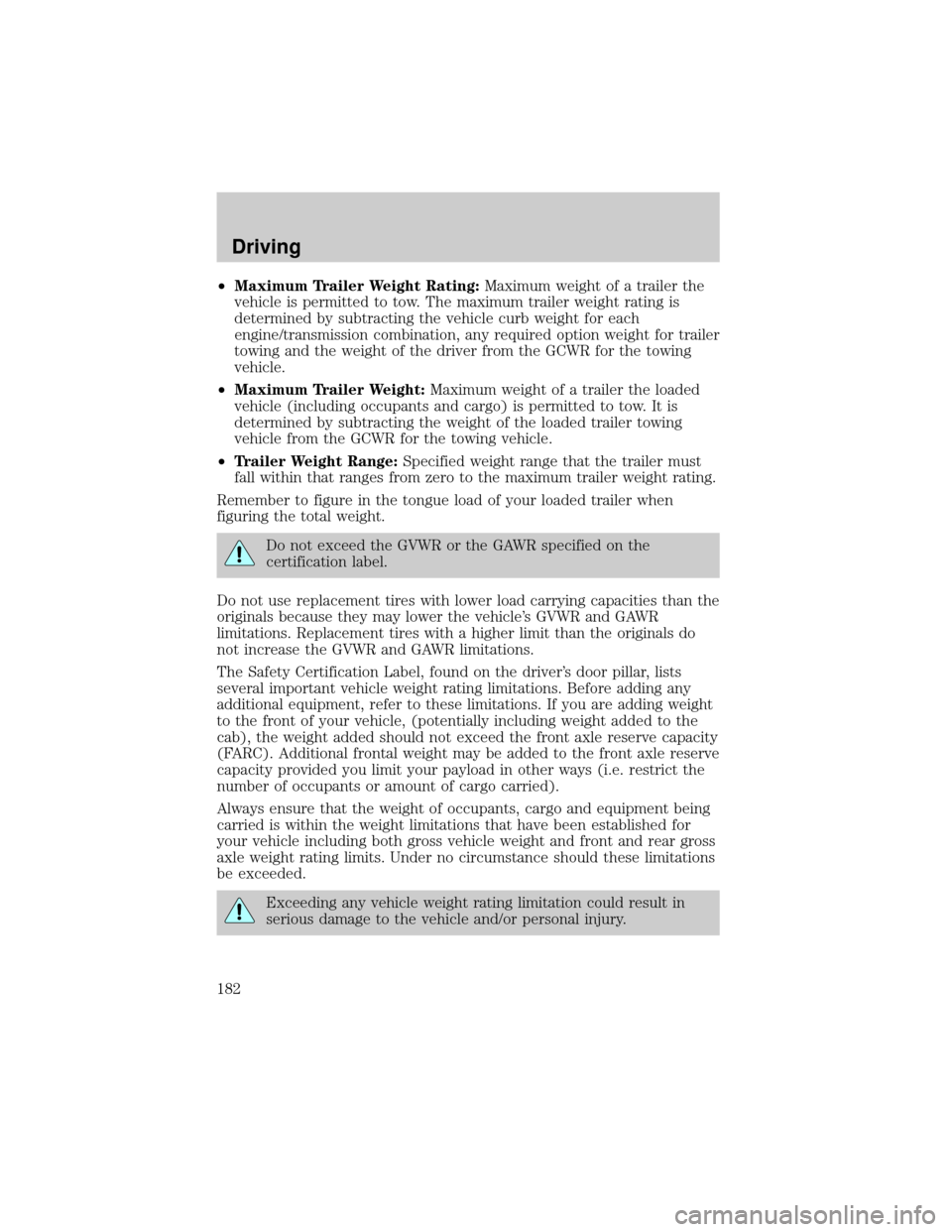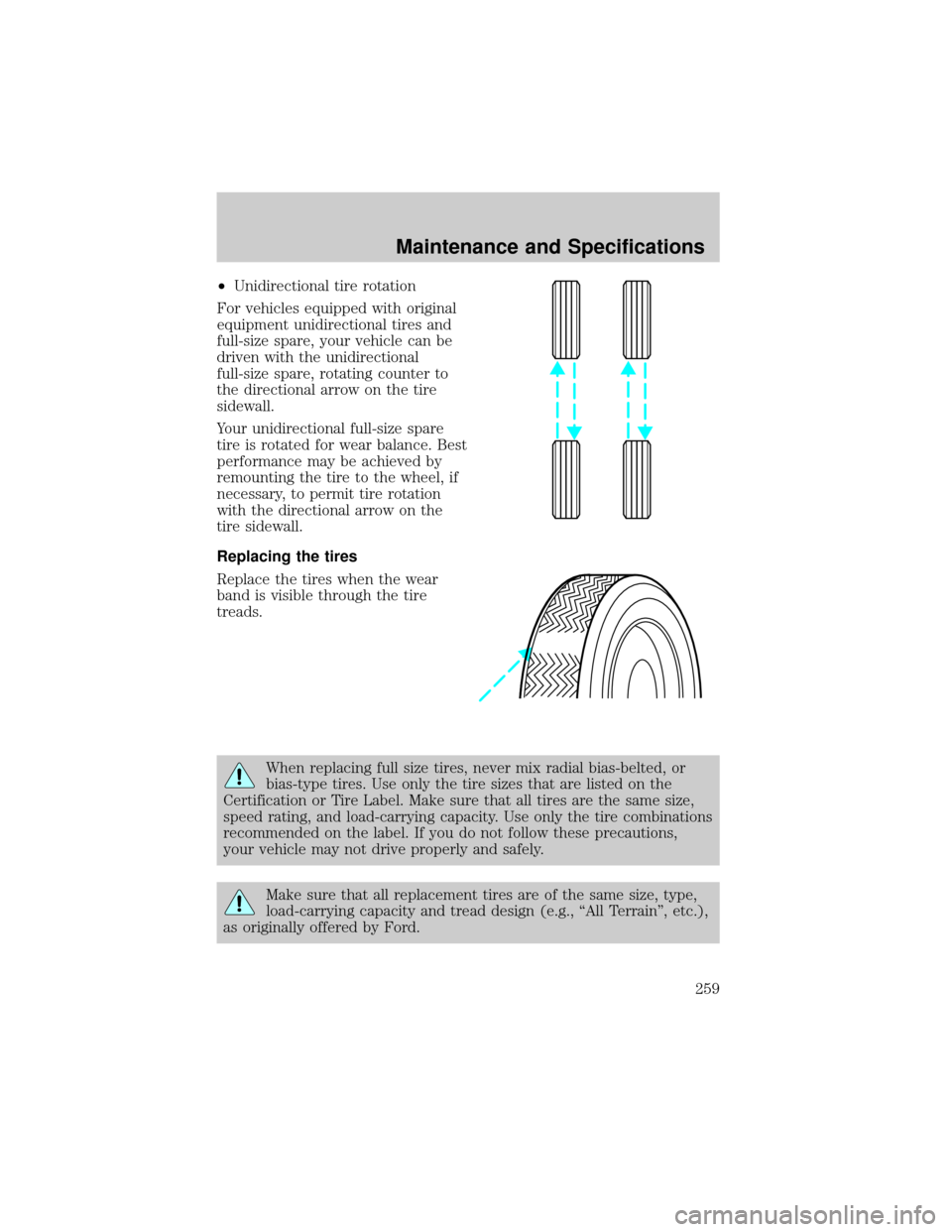load capacity LINCOLN LS 2002 Owners Manual
[x] Cancel search | Manufacturer: LINCOLN, Model Year: 2002, Model line: LS, Model: LINCOLN LS 2002Pages: 288, PDF Size: 2.44 MB
Page 181 of 288

DRIVING THROUGH WATER
Do not drive quickly through standing water, especially if the depth is
unknown. Traction or brake capability may be limited and if the ignition
system gets wet, your engine may stall. Water may also enter your
engine's air intake and severely damage your engine.
If driving through deep or standing water is unavoidable, proceed very
slowly. Never drive through water that is higher than the bottom of the
hubs (for trucks) or the bottom of the wheel rims (for cars).
Once through the water, always try the brakes. Wet brakes do not stop the
vehicle as effectively as dry brakes. Drying can be improved by moving your
vehicle slowly while applying light pressure on the brake pedal.
Driving through deep water where the transmission vent tube is
submerged may allow water into the transmission and cause
internal transmission damage.
VEHICLE LOADING
Before loading a vehicle, familiarize yourself with the following terms:
²Base Curb Weight:Weight of the vehicle including any standard
equipment, fluids, lubricants, etc. It does not include occupants or
aftermarket equipment.
²Payload:Combined maximum allowable weight of cargo, occupants
and optional equipment. The payload equals the gross vehicle weight
rating minus base curb weight.
²GVW (Gross Vehicle Weight):Base curb weight plus payload
weight. The GVW is not a limit or a specification.
²GVWR (Gross Vehicle Weight Rating):Maximum permissable total
weight of the base vehicle, occupants, optional equipment and cargo.
The GVWR is specific to each vehicle and is listed on the Safety
Certification Label on the driver's door pillar.
²GAWR (Gross Axle Weight Rating):Carrying capacity for each axle
system. The GAWR is specific to each vehicle and is listed on the
Safety Certification Label on the driver's door pillar.
²GCW (Gross Combined Weight):The combined weight of the
towing vehicle (including occupants and cargo) and the loaded trailer.
²GCWR (Gross Combined Weight Rating):Maximum permissable
combined weight of towing vehicle (including occupants and cargo)
and the loaded trailer
Driving
181
Page 182 of 288

²Maximum Trailer Weight Rating:Maximum weight of a trailer the
vehicle is permitted to tow. The maximum trailer weight rating is
determined by subtracting the vehicle curb weight for each
engine/transmission combination, any required option weight for trailer
towing and the weight of the driver from the GCWR for the towing
vehicle.
²Maximum Trailer Weight:Maximum weight of a trailer the loaded
vehicle (including occupants and cargo) is permitted to tow. It is
determined by subtracting the weight of the loaded trailer towing
vehicle from the GCWR for the towing vehicle.
²Trailer Weight Range:Specified weight range that the trailer must
fall within that ranges from zero to the maximum trailer weight rating.
Remember to figure in the tongue load of your loaded trailer when
figuring the total weight.
Do not exceed the GVWR or the GAWR specified on the
certification label.
Do not use replacement tires with lower load carrying capacities than the
originals because they may lower the vehicle's GVWR and GAWR
limitations. Replacement tires with a higher limit than the originals do
not increase the GVWR and GAWR limitations.
The Safety Certification Label, found on the driver's door pillar, lists
several important vehicle weight rating limitations. Before adding any
additional equipment, refer to these limitations. If you are adding weight
to the front of your vehicle, (potentially including weight added to the
cab), the weight added should not exceed the front axle reserve capacity
(FARC). Additional frontal weight may be added to the front axle reserve
capacity provided you limit your payload in other ways (i.e. restrict the
number of occupants or amount of cargo carried).
Always ensure that the weight of occupants, cargo and equipment being
carried is within the weight limitations that have been established for
your vehicle including both gross vehicle weight and front and rear gross
axle weight rating limits. Under no circumstance should these limitations
be exceeded.
Exceeding any vehicle weight rating limitation could result in
serious damage to the vehicle and/or personal injury.
Driving
182
Page 259 of 288

²Unidirectional tire rotation
For vehicles equipped with original
equipment unidirectional tires and
full-size spare, your vehicle can be
driven with the unidirectional
full-size spare, rotating counter to
the directional arrow on the tire
sidewall.
Your unidirectional full-size spare
tire is rotated for wear balance. Best
performance may be achieved by
remounting the tire to the wheel, if
necessary, to permit tire rotation
with the directional arrow on the
tire sidewall.
Replacing the tires
Replace the tires when the wear
band is visible through the tire
treads.
When replacing full size tires, never mix radial bias-belted, or
bias-type tires. Use only the tire sizes that are listed on the
Certification or Tire Label. Make sure that all tires are the same size,
speed rating, and load-carrying capacity. Use only the tire combinations
recommended on the label. If you do not follow these precautions,
your vehicle may not drive properly and safely.
Make sure that all replacement tires are of the same size, type,
load-carrying capacity and tread design (e.g., ªAll Terrainº, etc.),
as originally offered by Ford.
Maintenance and Specifications
259
Page 267 of 288

The advertised capacity is the amount of the indicated capacity and the
empty reserve combined. Indicated capacity is the difference in the
amount of fuel in a full tank and a tank when the fuel gauge indicates
empty. Empty reserve is the small amount of fuel remaining in the fuel
tank after the fuel gauge indicates empty.
The amount of usable fuel in the empty reserve varies and should
not be relied upon to increase driving range. When refueling your
vehicle after the fuel gauge indicates empty, you might not be
able to refuel the full amount of the advertised capacity of the
fuel tank due to the empty reserve still present in the tank.
For consistent results when filling the fuel tank:
²Turn the engine/ignition switch to the off position prior to refueling,
an error in the reading will result if the engine is left running.
²Use the same filling rate setting (low Ð medium Ð high) each time
the tank is filled.
²Allow no more than 2 automatic click-offs when filling.
²Always use fuel with the recommended octane rating.
²Use a known quality gasoline, preferably a national brand.
²Use the same side of the same pump and have the vehicle facing the
same direction each time you fill up.
²Have the vehicle loading and distribution the same every time.
Your results will be most accurate if your filling method is consistent.
Calculating fuel economy
1. Fill the fuel tank completely and record the initial odometer reading
(in kilometers or miles).
2. Each time you fill the tank, record the amount of fuel added (in liters
or gallons).
3. After at least three to five tank fill-ups, fill the fuel tank and record
the current odometer reading.
4. Subtract your initial odometer reading from the current odometer
reading.
5. Follow one of the simple calculations in order to determine fuel
economy:
Multiply liters used by 100, then divide by total kilometers
traveled.
Maintenance and Specifications
267
Page 278 of 288

Engine ................................264±265
check engine/service
engine soon light ......................10
cleaning ...................................222
coolant .....................................237
fail-safe coolant ......................242
idle speed control ...................235
lubrication specifications 263±264
refill capacities ........................261
service points ..................230±231
starting after a collision .........189
Engine block heater .................159
Engine fan .................................244
Engine oil ..................................232
checking and adding ..............232
dipstick ....................................232
filter, specifications ........234, 261
recommendations ...................234
refill capacities ........................261
specifications ..................263±264
Exhaust fumes ..........................159
F
Fail safe cooling ........................242
Floor mats .................................107
Fluid capacities .........................261
Foglamps .....................................61
Fuel ............................................245
calculating fuel
economy ............................96, 266
cap .....................................11, 247
capacity ...................................261
choosing the right fuel ...........248
comparisons with EPA
fuel economy estimates .........269
detergent in fuel .....................249
filling your vehicle
with fuel ..................245, 247, 266filter, specifications ........250, 261
fuel pump shut-off switch .....189
gauge .........................................17
improving fuel economy ........266
low fuel warning light ..............14
octane rating ...........248, 264±265
quality ......................................249
running out of fuel .................249
safety information relating
to automotive fuels ................245
Fuses ..................................190±191
G
Garage door opener ....................86
Gas cap (see Fuel cap) ......11, 247
Gas mileage (see Fuel
economy) ...................................266
Gauges .........................................16
engine coolant temperature
gauge .........................................16
fuel gauge ..................................17
odometer ...................................17
speedometer .............................17
tachometer ................................18
trip odometer ............................17
GAWR (Gross Axle Weight
Rating) .......................................181
definition .................................181
driving with a heavy load ......181
location ....................................181
GVWR (Gross Vehicle Weight
Rating) .......................................181
calculating ...............................181
definition .................................181
driving with a heavy load ......181
location ....................................181
Index
278
Page 280 of 288

low fuel ......................................14
low washer fluid .......................14
oil pressure ...............................12
safety belt .................................12
speed control ............................83
steering column lock ................14
traction control active ..............13
transmission PRNDL
indicator ....................................13
turn signal indicator .................14
Load limits .................................181
GAWR ......................................181
GVWR ......................................181
trailer towing ..........................181
Locks
autolock ...................................115
childproof ................................109
doors ........................................108
Lubricant
specifications .....................263±264
Lug nuts, anti-theft ...................201
Lumbar support, seats .............122
M
Manual transmission .................177
fluid capacities ........................261
lubricant specifications ..........264
reverse .....................................180
Message center .....................94±95
select button .............................94
warning messages .....................98
Mirrors .........................................73
automatic dimming rearview
mirror ........................................74
heated ........................................78
programmable memory ..........116
side view mirrors (power) .......77Moon roof ....................................86
Motorcraft parts ................250, 261
O
Octane rating ............................248
Odometer .....................................17
Oil (see Engine oil) ..................232
P
Panic alarm feature, remote
entry system ..............................113
Parking brake ............................162
Parts (see Motorcraft parts) ....261
Power distribution box
(see Fuses) .......................193, 196
Power door locks ..............108, 115
Power steering ..........................163
fluid, checking and adding ....250
fluid, refill capacity ................261
fluid, specifications .........263±264
R
Rear window defroster ...............59
Relays ........................................190
Remote entry system .......111, 113
illuminated entry ....................115
locking/unlocking
doors ................................112±113
opening the trunk ...................114
panic alarm .............................113
replacement/additional
transmitters .............................115
replacing the batteries ...........114
Roof rack ...................................107
Index
280